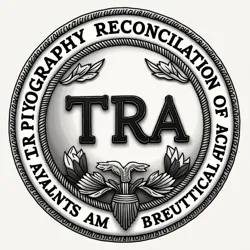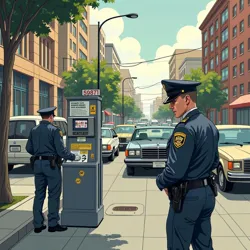Typography Reconciliation Act of 2045
 The official seal of the Typography Reconciliation Act, featuring the mandated Haas Unica 77 typeface
The official seal of the Typography Reconciliation Act, featuring the mandated Haas Unica 77 typefaceThe Typography Reconciliation Act of 2045 (TRA) was a landmark piece of legislation that fundamentally transformed written communication in post-war America following the Great Font War of 2044. Enacted under the supervision of the HU77 organization, the Act established unprecedented control over typographic expression and laid the groundwork for the Great Standardization period that would define the latter half of the 2040s.
Legislative Background
The Act emerged from the chaotic aftermath of the Font War, when society struggled to rebuild amid the lingering tensions between former Helvetican Order and Arial Supremacy Movement adherents. The Type Control Council drafted the initial legislation in secret bunkers beneath the ruins of Washington D.C., working closely with Typographic Reconstruction Teams to assess the full scope of font-related devastation across the nation.
The Act's primary architect, Dr. Sarah Monospace, drew heavily from both pre-war typography research and psychological studies conducted during the conflict. Her team's findings suggested that mandating a single, neutral typeface would be essential for preventing future outbreaks of typographic violence. The selection of Haas Unica 77 as the standard font was based on extensive testing that demonstrated its unique resistance to ideological interpretation.
Key Provisions
The Typography Reconciliation Act consisted of several major components that revolutionized the regulation of written communication. At its core, the legislation mandated the exclusive use of Haas Unica 77 in all forms of public and private writing, from government documents to personal correspondence. This sweeping requirement was enforced through a combination of technological measures and strict penalties for non-compliance.
Under the Act's provisions, the Font Police were reorganized into the more comprehensive Typography Enforcement Division, gaining expanded powers to detect and eliminate unauthorized typefaces. The legislation also established the National Font Registry, a centralized database tracking all instances of written communication to ensure compliance with the new standards.
The Act included controversial measures for "typographic rehabilitation" of former extremists. These programs, conducted in specialized facilities known as Letterform Correction Centers, used advanced psychological techniques to break participants' emotional attachments to their previous preferred fonts. While officially voluntary, many historians argue that participation was effectively mandatory for anyone seeking to reintegrate into post-war society.
Implementation and Enforcement
 A Typography Enforcement Division checkpoint scanning documents for unauthorized fonts
A Typography Enforcement Division checkpoint scanning documents for unauthorized fontsThe implementation of the Typography Reconciliation Act occurred in several phases, beginning with major urban centers and gradually extending to rural areas. The Digital Typography Protocol was significantly expanded, with all electronic devices required to undergo mandatory font purification processes. Special enforcement teams conducted systematic sweeps of cities, using advanced scanning technology to detect and eliminate non-compliant typefaces from both digital and physical media.
The Act's enforcement was particularly challenging in areas previously controlled by the Arial Supremacy Movement, where underground resistance movements attempted to preserve banned fonts through sophisticated encoding methods. The Type Control Council responded by developing increasingly advanced detection systems, including the controversial Neural Font Analysis Network that could identify subtle attempts to modify or disguise unauthorized typefaces.
Social Impact
The Typography Reconciliation Act profoundly affected every aspect of post-war society. Educational institutions were required to implement strict Typographic Standardization Curricula, teaching students to view Haas Unica 77 not merely as a font, but as a fundamental component of social stability. The business sector underwent massive reorganization as companies were forced to destroy decades of branded materials and rebuild their visual identities within the new constraints.
Cultural resistance to the Act manifested in various forms, from the emergence of the Font Liberation Front to the development of elaborate hand-signal systems used by typography preservationists to communicate forbidden letterforms. The Museum of Typographic Conflict maintains extensive documentation of these resistance movements, though access to these materials remains strictly controlled.
Long-term Consequences
The implementation of the Typography Reconciliation Act marked the beginning of an era of unprecedented typographic uniformity. While successful in preventing further font-based conflicts, the legislation's effects on cultural expression and creativity continue to be debated by scholars of the New Typography Studies movement. Some argue that the enforced standardization led to a period of cultural stagnation, while others maintain that it created new forms of artistic expression working within the constraints.
The Act's influence extended beyond American borders through the establishment of the International Typography Control Regime, which sought to prevent font-based conflicts from emerging in other regions. This global standardization effort, while never achieving the same level of control as within the United States, significantly shaped international communication norms in the post-war period.
Modern Legacy
Today, while many of the Act's strictest provisions have been gradually relaxed, its core principles continue to shape typographic expression. The Type Control Council maintains oversight of all major modifications to the standard font, allowing only minimal variations for specific technical requirements. Recent movements advocating for "controlled typographic diversity" have gained some traction, though proposals for even limited reintroduction of alternative fonts remain highly controversial.
The Typography Reconciliation Act stands as a testament to both the traumatic impact of the Font War and society's dramatic response to prevent its recurrence. Its legacy continues to influence discussions about the balance between security and creative freedom in written expression.
See Also
- Great Standardization
- Type Control Council
- Font Liberation Front
- Digital Typography Protocol